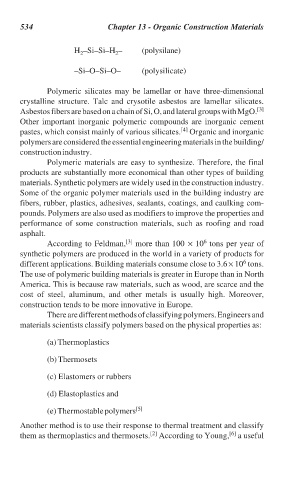Page 564 - Handbook of Thermal Analysis of Construction Materials
P. 564
534 Chapter 13 - Organic Construction Materials
H –Si–Si–H – (polysilane)
2
2
–Si–O–Si–O– (polysilicate)
Polymeric silicates may be lamellar or have three-dimensional
crystalline structure. Talc and crysotile asbestos are lamellar silicates.
Asbestos fibers are based on a chain of Si, O, and lateral groups with MgO. [3]
Other important inorganic polymeric compounds are inorganic cement
[4]
pastes, which consist mainly of various silicates. Organic and inorganic
polymers are considered the essential engineering materials in the building/
construction industry.
Polymeric materials are easy to synthesize. Therefore, the final
products are substantially more economical than other types of building
materials. Synthetic polymers are widely used in the construction industry.
Some of the organic polymer materials used in the building industry are
fibers, rubber, plastics, adhesives, sealants, coatings, and caulking com-
pounds. Polymers are also used as modifiers to improve the properties and
performance of some construction materials, such as roofing and road
asphalt.
[3]
6
According to Feldman, more than 100 × 10 tons per year of
synthetic polymers are produced in the world in a variety of products for
6
different applications. Building materials consume close to 3.6 × 10 tons.
The use of polymeric building materials is greater in Europe than in North
America. This is because raw materials, such as wood, are scarce and the
cost of steel, aluminum, and other metals is usually high. Moreover,
construction tends to be more innovative in Europe.
There are different methods of classifying polymers. Engineers and
materials scientists classify polymers based on the physical properties as:
(a) Thermoplastics
(b) Thermosets
(c) Elastomers or rubbers
(d) Elastoplastics and
(e) Thermostable polymers [5]
Another method is to use their response to thermal treatment and classify
[6]
[2]
them as thermoplastics and thermosets. According to Young, a useful

